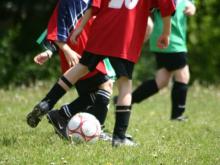Most children and young adult patients with congenital heart disease can and should engage in some form of physical activity and should avoid a sedentary lifestyle, according to a task force scientific statement from the American Heart Association and the American College of Cardiology (AHA/ACC).
This recommendation comes despite the fears of sudden cardiac death (SCD) in young athletes, which formed the initial impetus of the entire series of task force reports.
The recommended level of sports participation for patients with treated or untreated congenital heart defect, however, should consider the training and the competitive aspects of the sport itself and must be individualized to the patient. This means taking into account the patient’s current functional status, history of surgery, and the presence of implanted cardiac devices, according to the report by Dr. George F. Van Hare of Washington University, St. Louis, and his colleagues, which was published online in the Journal of the American College of Cardiology.
The report breaks down its specific recommendations based upon the various types of congenital heart defect (CHD). Full details and nuances of the recommendations and their specific levels of evidence for each individual condition and the many variants can be found in the online publication. Below is a brief and selected summary for some of the most common defects and some of those most pertinent to sudden cardiac death in young athletes.
Simple shunting lesions (atrial septal defect, ventricular septal defect, patent ductus arteriosus): Treated and untreated
In addressing the three most common subtypes of CHD – ventricular septal defect (VSD, 34%), atrial septal defect (ASD, 13%), and patent ductus arteriosus (PDA, 10%) – the committee found no data that children with these lesions are related to acknowledged episodes of sudden cardiac death (SCD). This applied whether the defects were closed or remained open. “With rare exceptions, patients with hemodynamically insignificant CHD such as VSD, ASD, and PDA may participate competitively in all sports,” it concluded. These recommendations fall under class I; level of evidence C for almost all of these patients, according to the writing committee.
Congenital coronary anomalies: Treated and untreated
Anomalies of coronary arteries are the second-most commonly identified structural causes of SCD in competitive athletes, accounting for about 17% of such deaths in the United States, according to the report. The vast majority of sudden deaths associated with coronary anomalies occur during or shortly after exercise. Despite being less commonly represented in patients, among athletes who have died suddenly, anomalous origin of the left main or left anterior descending coronary artery from the right sinus of Valsalva is far more prevalent. In addition, SCDs are most strongly associated with the pattern in which the anomalous left coronary artery passes between the aorta and main pulmonary artery. Recommended return to intense athletic activities is only to be permitted at least 3 months after surgery, and with a demonstration of the absence of ischemia on postoperative stress testing, with evidence levels depending on the type of anomaly. Of note, in contrast, the committee indicated that athletes with an anomalous origin of a right coronary artery from the left sinus of Valsalva should simply be evaluated by an exercise stress test, and for those without symptoms or a positive exercise stress test, permission to compete can be considered after adequate counseling (class IIa; level of evidence C).
Pulmonary valve stenosis: Treated and untreated
The committee determined that athletes with mild pulmonary stenosis (PS) and normal right ventricular (RV) function can participate in all competitive sports, although annual reevaluation also is recommended (class I; level of evidence B). In addition, athletes treated by operation or balloon valvuloplasty who have achieved adequate relief of PS (gradient less than 40 mm Hg by Doppler) can participate in all competitive sports (class I; level of evidence B). Other patients should be restricted to low-intensity sports, according to the committee.
Aortic valve stenosis: Treated and untreated
Children and adolescents with aortic stenosis (AS) are differentiated between those with mild, moderate, and severe AS by physical examination, ECG, and Doppler echocardiography. In all cases, regardless of the degree of stenosis, patients with a history of fatigue, light-headedness, dizziness, syncope, chest pain, or pallor on exercise deserve a full evaluation. Annual re-evaluation is required for all patients with AS because the disease can progress. Patients with severe AS are at risk of sudden death, particularly with exercise. The committee determined that athletes with mild AS can participate in all competitive sports (class I; level of evidence B), but that athletes with severe AS should be restricted from all competitive sports, with the possible exception of low-intensity sports (class III; level of evidence B).



